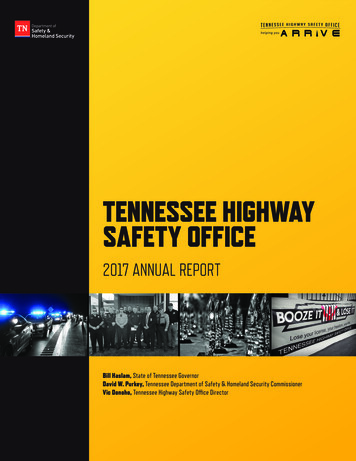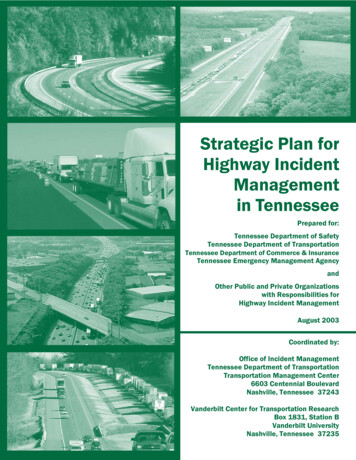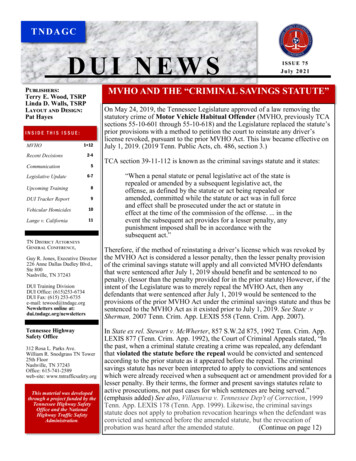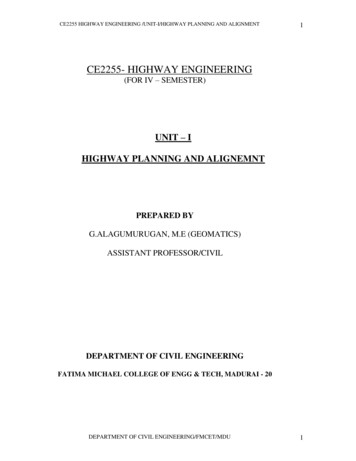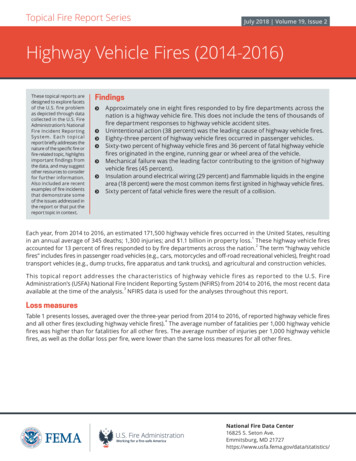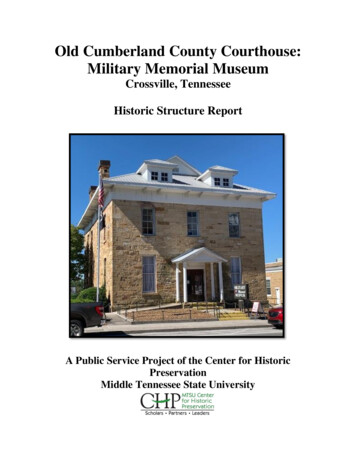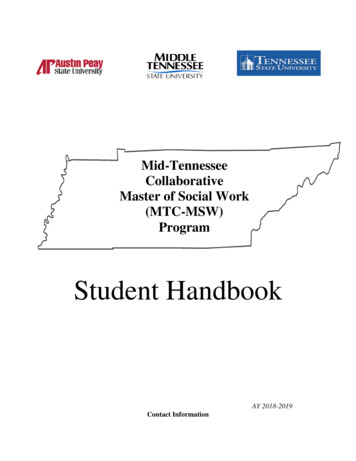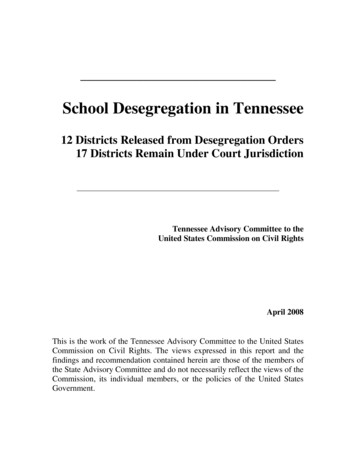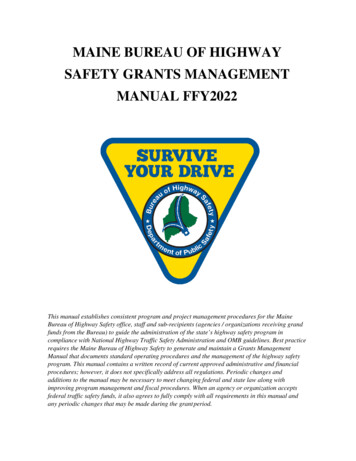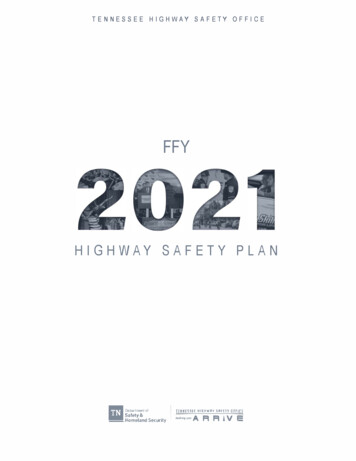
Transcription
TENNESSEE HIGHWAY SAFETY OFFICEFFYHIGHWAY SAFETY PLANIiiDepartment of- ::t:i:nd SecurityITENNESSEEhe/ping youHIGHWRYSRFETY OFFICEA Fl Fl ! Ve
Table of ContentsTable of Contents . 2National Priority Safety Program Incentive Grants . 4Commonly Used Abbreviations . 5Highway Safety Planning Process. 6Data Sources and Processes. 6Processes Participants. 6Description of Highway Safety Problems. 7Methods for Project Selection. 7List of Information and Data Sources . 12Description of Outcomes . 13Performance Report . 14Performance Plan . 22Certification. 43Program Areas. 44Program Area: Planning & Administration. 44Program Area: Police Traffic Services . 48Program Area: Occupant Protection (Adult and Child Passenger Safety) . 60Program Area: Traffic Records . 81Program Area: Impaired Driving (Alcohol and Drug). 85Program Area: Distracted Driving . 98Program Area: Motorcycle Safety . 102Program Area: Teen Traffic Safety Program. 107Program Area: Non-Motorized (Pedestrian and Bicyclists).112Program Area: Communications (Media). 117Program Area: Community Traffic Safety Program. 124Program Area: Emergency Medical Services (EMS) . 126Program Area: Older Driver . 129Program Area: Training. 133
Evidence-based Traffic Safety Enforcement Program (TSEP).137Crash Analysis . 137Deployment of Resources. 137Effectiveness of Monitoring . 138High-Visibility Enforcement (HVE) Strategies. 140Appendices . 141
National Priority Safety Program Incentive GrantsThe State applied for the following incentive grants:1. 405(b) Occupant Protection: Yes2. 405(c) State Traffic Safety Information System Improvements: Yes3. 405(d) Impaired Driving Countermeasures: Yes4. 405(d) 24-7 Sobriety Programs: No5. 405(d) Alcohol-Ignition Interlock Law: No6. 405(e) Distracted Driving: No7. 405(f) Motorcyclist Safety Grants: Yes8. 405(g) State Graduated Driver Licensing Incentive: No9. 405(h) Nonmotorized Safety: No10. 1906 Racial Profiling Data Collection: No4
Commonly Used HTDOSHSTDOTTHPTHSOTIMTITANTRCCTSRPAdvanced Roadside Impaired Driving EducationCenters for Disease ControlContinuing Education UnitClick It or TicketChild Passenger SafetyChild Passenger Safety TechnicianDepartment of Motor VehicleDrug Recognition ExpertDriving Under the InfluenceEmergency Medical ServicesFixing America’s Surface TransportationFatality Analysis Reporting SystemFederal Fiscal YearFederal Highway AdministrationGraduated Driver's LicenseHigh Visibility EnforcementInternational Association of Chiefs of PoliceImpaired Driving Task ForceLaw Enforcement LiasionLight Imaging Detection and RangingMothers Against Drunk DrivingMetropolitan Planning OrganizationMotorcycle Rider Education ProgramNational Digital Check Form (CPS)National Highway Traffic Safety AdministrationPolice Officer Standards and TrainingPolice Traffic ServicesRadio Detection and RangingStudents Against Destructive DecisionsSeatbelts Are For EveryoneStandardized Field Sobriety TrainingStrategies and Tactics of Patrol StopsTennessee Department of HealthTennessee Department of Safety and Homeland SecurityTennessee Department of TransportationTennessee Highway PatrolTennessee Highway Safety OfficeTraffic Incident ManagementTennessee Integrated Traffic Analysis NetworkTennessee Traffic Records Coordinating CommitteeTraffic Safety Resource ProsecutorsVMTVehicle Miles Traveled5
Highway Safety Planning ProcessData Sources and ProcessesThe Tennessee Highway Safety Office’s (THSO) strategic planning process is a precise, datadriven effort, consisting of problem identification, project selection, and program evaluation. Westrive for higher standards as planners, managers, and evaluators with an emphasis onaccountability as we continue to implement our strategy for allocating federal highway funds tostate and local agencies.These processes are utilized to determine Tennessee’s traffic safety problems, goals, andprogram/project/activity emphasis.Processes ParticipantsSeveral committees and stakeholders are involved in the highway safety planning process.Tennessee receives input from its Traffic Records Coordinating Committee, Occupant ProtectTask Force, and the Impaired Driving Advisory Council. An example of this can be seen whenlooking at the composition of the Impaired Driving Advisory Council: 6Tennessee Sheriff’s Association (Law Enforcement)Tennessee Department of Health (Public Health)Tennessee Department of Mental Health and Substance Abuse Services (Treatment andRehabilitation)Tennessee Department of Safety and Homeland Security (Communications and PublicRelations)Tennessee Association of Chiefs of Police (Law Enforcement)Tennessee Department of Safety and Homeland Security (Ignition Interlock)Tennessee Department of Safety and Homeland Security (Driver Licensing)Tennessee Highway Safety Office (Administration)District Attorneys General Conference (Prosecution)Research, Planning, & Development / TITAN, Tennessee Department of Safety &Homeland Security (Data and Traffic Records)Judicial Outreach Liaison, The University of Tennessee, Knoxville (Adjudication)Judge, Hamilton County / Chattanooga (Adjudication)Metropolitan Government of Nashville Davidson County (Probation and Parole)Tennessee Wildlife Resources Agency (Law Enforcement)Tennessee Department of Correction (Corrections, Probation, and Parole)Tennessee Highway Patrol (Law Enforcement)Tennessee Bureau of Investigation (Law Enforcement)Administrative Office of the Courts (Courts)MADD (Citizen Activists)Local law enforcement
Description of Highway Safety ProblemsThe THSO and the National Highway Traffic Safety Administration (NHTSA) Regional ProgramManager review the data to determine the high priority areas that would be addressed with Section402 and Section 405 funding in Federal Fiscal Year (FFY) 2021.For FFY 2021, the THSO informed potential grantees that identifying any data-driven highwaysafety problem would garner a higher priority, but the following are characterized as high-priorityareas. These include a: Low rate of seat belt usage,Low rate of child passenger safety restraint usage,High rate of crashes with alcohol as a contributing factor,High rate of crashes with speeding as a contributing factor,High rate of crashes involving drivers under 20 years old,High rate of crashes involving an aggressive driver, andHigh rate of crashes resulting in serious injuries or fatalities.The specific highway safety problems that subgrantees address must be data-driven. They arerequired to identify an intervention that focuses on traffic safety problems that are statisticallyover-represented. To assist, agencies can request comparative analyses through the TennesseeIntegrated Traffic Analysis Network (TITAN) crash analysis system maintained by the TDOSHS.It is essential to determine the cause of injuries or fatal crashes; therefore, subgrantees areencouraged to carefully review the crash data and examine problems within their community tounmask the root causes for over-representation in the data-defined problem area.Performance goals, both short and long term, evolve from the problem identification process.Identified emphasis areas are selected from this process and reviewed to assure they areconsistent with the guidelines and emphasis areas established by NHTSA.The THSO released a Grant Application Guide to assist applicants in developing a high-qualityapplication. This guide includes explanations and examples for each section and is availablethrough the website (http://tntrafficsafety.org) and on the grants management system, TN Grants.7
Methods for Project SelectionThe FFY 2021 problem identification process began with a review of the state’s performance,utilizing 2015 to 2019 trend data. The THSO used data from the TDOSHS Planning, Research,and Development Division and subgrantees’ annual reports to give management staff anunderstanding of the highway safety problems within the State of Tennessee and identifyproductive programs and effective strategies utilized in 2019. Management staff convened todetermine funding priorities, both programmatic and geographic, and devised a plan for projectdevelopment for FFY 2021.Coordination with the 2014 Strategic Highway Safety Plan (SHSP) was another criticalconsideration. Tennessee’s SHSP was developed in consultation with federal, state, local, andprivate sector safety stakeholders using a data-driven, multidisciplinary approach involvingengineering, education, enforcement, and emergency response. Management reviewed theplan’s statewide goals, objectives, and emphasis areas.Announcements regarding the FFY 2021 Highway Safety Program were sent (mailed andemailed) to potential state and local subgrantees, including all police chiefs and sheriffs. Anexample is provided at the end of this section. A notification was also posted on the THSO’swebsite (www.TNTrafficSafety.org) and social media sites, Facebook and Twitter. The followingcharacteristics are considered to be necessary as part of the grant application process: 8Interventions that focus on reducing injury crashes;Problem-identification procedures that are data-driven and that thoroughly document alocal crash injury problem;Data collection systems that ensure high-quality crash reporting by law enforcement (e.g.,accuracy and completeness of forms, supervisory oversight, training, etc.);Plans to link crash data to medical information concerning such variables as the severityof the injury, cost of treatment, degree of incapacitation, etc.;Documentation of the rationale that the intervention selected has a reasonable probabilityof being effective;An adequate intervention design that will provide meaningful outcome data on the degreeof success in reducing injury crashes. The applicant must describe how the program’seffectiveness will be measured and the comparison data against which the program’soutcome will be evaluated; andWhere local conditions permit, initiatives to coordinate crash-injury reduction efforts withother injury-reduction activities within the community, by participating in cooperative effortswith other professionals and citizens (e.g., educational, civic, judicial, business, medical,etc.) involved in creating a safe community.
Potential subgrantees were informed that a full grant proposal for FFY 2021 funding had to besubmitted detailing the following: the process for focusing on traffic safety problems that were data-driven,the logic behind their proposed intervention strategies,the allowance for valid outcome measures in their project design, andthe proposed budget.The deadline for highway safety grant applications for FFY 2021 funding was March 31, 2020. Atotal of 438 applications (264 programmatic and 174 high visibility enforcement) were submittedto the THSO. After grant applications are received, each application is reviewed in detail todetermine if it meets the THSO’s goals, objectives, and project design requirements and is givena score. Based on this analysis, the THSO management team discusses the application scoresand other considerations. These other considerations could include: Current or past grant performance,Likelihood of project to reduce crashes, injuries, and fatalities significantly, andMulti-jurisdictional nature of the project.Once all of these items have been considered, the THSO management team can reach aconsensus on which grants to award.Funding is also a data-driven process through the use of a ranking and allocation tool that ensurescounties (enforcement agencies) are funded on a comparable basis. It considers the extent of: Weighted fatal, injury, and property damage only (PDO) crashes,Alcohol-related crashes; 15-24 aged driver crashes,65 aged crashes,Speeding crashes,Motorcycle crashes,Population, andVehicle miles traveled in each county.Comparable basis refers to normalizing the county numbers relative to that of the county with thehighest value.Recommendations for funding are then made to the commissioner of the TDOSHS, who servesas the Tennessee Governor‘s Representative.A project director is assigned for each project. The project director is typically the person whosubmitted the project, or the person responsible for the “subject” of the agency’s project. Further,a program manager from the THSO is assigned to provide assistance and oversight to eachsubgrantee during the fiscal year to ensure that agencies accomplish their approved programinitiatives; the practical application of this assistance is in the form of consulting services andtechnical support. For instance, the program manager monitors the activity of grantees, reviewsclaims, and makes recommendations to the director for a continuation of the program. Additionalresponsibilities include reviewing quarterly reports from the subgrantees, monitoring projectactivity on-site at least once per year, and providing daily office management. Also, feedback is9
provided to each subgrantee regarding the strengths and weaknesses of project activities. Finally,suggestions are provided on how the subgrantee should proceed to achieve the results describedin the original grant proposal if such assistance is needed.The following is a tentative schedule of the highway safety program planning process and howthat integrates with the grant application process.FFY 2021 Highway Safety Program Planning Schedule (Tentative)January - FebruaryData collection and review for problem identificationMarch 1Grant application period begins online; establish a draft budgetfor management reviewMarchAttend LEL network meetings to discusses the applicationprocess and help agencies apply for HVE grantsMarch 31Grant application deadlineMarch 15 - April 30Grant application review processMay 1THSO applies for Delegated Authority (DA) for sports/mediacontractsMay 1THSO applies for Delegated Grant Authority (DGA)May 10THSO management meeting to finalize grants awardsMay 17Grant assignment meetingMay 24Create a spreadsheet and update the online system with grantnumbers, etc.July 1Highway Safety Plan and 405 applications dueJuly 1 – 31Grant application revisions (programmatic and financial)July 10Meet with TDOSHS Legal about contract format and languageAugust 2Spreadsheet to PIO and then forwarded to TDOSHS for pressreleaseAugust 2Denial letters go out to subgrantees/applicantsAugust 4Create subgrantee file foldersAugust 14 - 25Subgrantees receive grant contract and attachments forsignaturesAugust-SeptemberGrant contracts submitted to TDOSHS Finance, Legal, andCommissioner for approvalSeptember 30Grants awarded, with a copy placed in the subgrantee fileOctober 1Grant year begins; begin work on the Annual ReportOctober-NovemberGrant orientation workshopsDecember 1 - 14Closeout process completeDecember 31Annual Report due10
Sample of FFY 2021 grant announcement:11
List of Information and Data SourcesSeveral data sources were reviewed in order to develop appropriate strategies and projects:Abell, AJ. May 1, 2020. Nashville Tourism Hit Hard: 4th of July Likely Off, 835 ConventionsCanceled. WZTV [Online]. Available: edBoyd Center for Business and Economic Research, Tennessee State Data Center. “2019Population Estimates Show Continued Growth in Tennessee, Southeastern States,”[Online]. Available: stern-states/Beene, Ryan. (April 15, 2020). America’s Empty Roads: Fewer Deaths But a Blow to StateBudgets. Bloomberg. [Online]. -blow-to-state-budgetsDUI Tracker, TDOSHS Planning, Research and Development (TDOSHS)Fatality Analysis Reporting System (FARS)Federal Highway Administration, Office of Highway Policy Information, 2013-2018, State TablesVehicle-miles of travel, by functional system, [Online]. on/statistics.cfmNational Institutes for Health website: https://www.nih.gov/NHTSA. (2009) National Emergency Medical Services Education Standards. Retrieved fromhttps://www.ems.gov/pdf/811077a.pdfRichard, C.M., Magee, K., Bacon-Abdelmoteleb, P., & Brown, J. L. (2018, April).Countermeasures That Work: a highway safety countermeasure guide for State HighwaySafety Offices, Ninth edition (Report No. DOT HS 812 478). Washington, DC: NationalHighway Traffic Safety Administration.Research Notes, Crash Stats, and Traffic Safety Fact Sheets, National Highway Traffic SafetyAdministration (NHTSA)Tennessee Integrated Traffic Analysis Network (TITAN)Tennessee Department of Safety and Homeland Security, TITAN Division, (2020). “TennesseeTraffic Fatalities Daily Report.” [Data set].TDOSHS, TITAN Division, (2020). “Tennessee Traffic Fatalities Historical Report 2015-2019.”[Data set]. /documents/dailyfatality2019.pdfTITAN Business Unit. (2020). Tennessee traffic crash data. Tennessee Department of Safetyand Homeland Security. /documents/CountyCrashRankings2019.pdfUniform Guidelines for State Highway Safety ProgramsWatson, Len. The Platinum Ten. Retrieved f12
Description of OutcomesThe THSO shares three common performance targets with the Highway Safety ImprovementProgram: number of fatalities, rate of fatalities, and number of serious injuries. These performancemeasures are shared with our state’s Strategic Highway Safety Plan (SHSP). The Safety PMWorking Group consists of staff from the Tennessee Department of Transportation (TDOT), theTDOSHS, the Federal Highway Administration, and Metropolitan Planning Organizations(MPOs) from within the state. The target setting process consisted of data review, trendanalysis, context/consideration of crucial factors, consensus on target setting assumptions,and discussion and consensus on draft targets. The Safety PM Working Group providedrecommendations to an oversight committee, which included directors from both TDOT and theTHSO. Finalized targets were presented to the executive leadership at both agencies for reviewand approval.The shared targets are based on a 5-year rolling average, using data from the Fatality AnalysisReporting System (FARS) for fatalities, state databases for data about serious injuries, andTDOT for vehicle miles traveled (VMT). Consequently, some targets are increasing, while othersare decreasing. Despite the numbers presented in some areas, the THSO and its partnersare committed to reducing fatalities and crashes in all performance areas. Our mission callsus to utilize education, enforcement, and outreach to change the apparent trendsfostering and sustaining changes in driver behavior.13
Performance ReportProgress towards meeting State performance targets from the previous fiscal year's HSPPerformance Measure NameC-1) Number of Traffic Fatalities (FARS)C-2) Number of Serious Injuries in Traffic Crashes (state crash data files)C-3) Fatalities/VMT (FARS, FHWA)C-4) Number of Unrestrained Passenger Vehicle Occupant Fatalities, All SeatPositions (FARS)C-5) Number of Fatalities in Crashes Involving a Driver or Motorcycle Operatorwith a BAC of .08 and Above (FARS)C-6) Number of Speeding-Related Fatalities (FARS)C-7) Number of Motorcyclist Fatalities (FARS)C-8) Number of Unhelmeted Motorcyclist Fatalities (FARS)C-9) Number of Drivers Age 20 or Younger Involved in Fatal Crashes (FARS)C-10) Number of Pedestrian Fatalities (FARS)C-11) Number of Bicyclists Fatalities (FARS)B-1) Observed Seat Belt Use for Passenger Vehicles, Front Seat OutboardOccupants (survey)Distracted driving fatalitiesUnique Viewers on TNTrafficSafety.orgEMS GrantsClassroom AttendanceARIDE TrainedSFST TrainedDRE TrainedLEADS TrainedPaid Media ImpressionsEarned Media EngagementsCounties DeployedPaper vs. ElectronicProgressIn ProgressIn ProgressIn ProgressIn ProgressIn ProgressIn ProgressIn ProgressIn ProgressIn ProgressIn ProgressIn ProgressAchievedIn ProgressIn ProgressAchievedIn ProgressIn ProgressIn ProgressIn ProgressAchievedIn ProgressIn ProgressNot MetMetPerformance Measure: C-1) Number of Traffic Fatalities (FARS)Progress:In ProgressProgram-Area-Level ReportThat THSO and its partner agencies are trending towards meeting the shared target set for thenumber of traffic fatalities. The shared performance target for FFY 2020 was to increase trafficfatalities by 4.52 percent, from 996.2 (2013-2017 average) to 1,043.4 (2016-2020 average).Preliminary data shows that the state averaged 1,039.8 traffic fatalities for 2015-2019 (average).14
Performance Measure: C-2) Number of Serious Injuries in Traffic Crashes (statecrash data files)Progress:In ProgressProgram-Area-Level ReportThe THSO and its partner agencies are trending towards meeting the shared target set for thenumber of serious injuries in traffic crashes. The shared performance target for FFY 2020 was todecrease serious injuries by 12.10 percent from 7,227.0 (2013-2017 average) to 6,352.4 (20142020 average). Preliminary data shows that the state averaged 6,725.4 serious injuries for 20152019 (average).Performance Measure: C-3) Fatalities/VMT (FARS, FHWA)Progress:In ProgressProgram-Area-Level ReportThe THSO and its partner agencies will strive to meet the shared target set for fatalities/VMT.The shared performance target for FFY 2020 was to decrease fatalities per vehicle miles traveled(VMT) by 4.78 percent from 1.319 percent (2013-2017 average) to 1.256 (2014-2020 average).Preliminary data shows that the state has a current 5-year fatality rate of 1.300 (2015-2019).Performance Measure: C-4) Number of Unrestrained Passenger Vehicle OccupantFatalities, All Seat Positions (FARS)Progress:In ProgressProgram-Area-Level ReportThe THSO will strive to meet the target measure for the number of unrestrained passenger vehicleoccupant fatalities, all seat positions. The FFY 2020 HSP set a target of 279, a 7.60 percentreduction from 2017. As of May 27, 2020, Tennessee has seen 140 unrestrained vehicleoccupant fatalities.15
Performance Measure: C-5) Number of Fatalities in Crashes Involving a Driver orMotorcycle Operator with a BAC of .08 and Above (FARS)Progress:In ProgressProgram-Area-Level ReportThe THSO is trending towards meeting the target measure for the number of fatalities in crashesinvolving a driver or operator with a BAC of .08 and above. The FFY 2020 HSP set a target of222, a 13.9 percent reduction from a 2013-2017 baseline. As of June 9, 2020, Tennessee hasseen 63 fatalities in crashes involving a driver or operator with a BAC of .08 and above.Performance Measure: C-6) Number of Speeding-Related Fatalities (FARS)Progress:In ProgressProgram-Area-Level ReportThe THSO is trending towards meeting the target measure for the number of speeding-relatedfatalities. The FFY 2020 HSP set a target of 163, an 18.2 percent reduction from a 2013-2017baseline. As of May 27, 2020, Tennessee has seen 67 speeding-related fatalities.Performance Measure: C-7) Number of Motorcyclist Fatalities (FARS)Progress:In ProgressProgram-Area-Level ReportThe THSO is trending towards meeting the target measure for the number of motorcycle fatalities.The FFY 2020 HSP set a target of maintaining 134 fatalities from 2017. As of May 27, 2020,Tennessee has seen 42 motorcycle fatalities.Performance Measure: C-8) Number of Unhelmeted Motorcyclist Fatalities (FARS)Progress:In ProgressProgram-Area-Level ReportThe THSO is trending towards meeting the target measure for unhelmeted motorcyclist fatalities.The FFY 2020 HSP set a target of 10, a 9.3 percent reduction from a 2015-2017 baseline. As ofMay 27, 2020, Tennessee has seen three unhelmeted motorcycle fatalities.16
Performance Measure: C-9) Number of Drivers Age 20 or Younger Involved inFatal Crashes (FARS)Progress:In ProgressProgram-Area-Level ReportThe THSO will strive to meet the target measure for the number of drivers age 20 or youngerinvolved in fatal crashes. The FFY 2020 HSP set a target of 98, a 14.4 percent reduction from a2015-2017 baseline. As of May 27, 2020, Tennessee has seen 53 young drivers involved in fatalcrashes.Performance Measure: C-10) Number of Pedestrian Fatalities (FARS)Progress:In ProgressProgram-Area-Level ReportThe THSO will strive to meet the target measure for the number of pedestrian fatalities. The FFY2020 HSP set a target of 148, a 16.2 percent increase from 2017. As of May 27, 2020, Tennesseehas seen 55 pedestrian fatalities.Performance Measure: C-11) Number of Bicyclists Fatalities (FARS)Progress:In ProgressProgram-Area-Level ReportThe THSO will strive to meet the target measure for the number of bicyclists fatalities. The FFY2020 HSP set a target to maintain eight bicycle fatalities from 2017. As of May 27, 2020,Tennessee has seen four bicyclists fatalities.Performance Measure: B-1) Observed Seat Belt Use for Passenger Vehicles,Front Seat Outboard Occupants (survey)Progress:AchievedProgram-Area-Level ReportThe THSO achieved the target measure for observed seat belt use for passenger vehicles. TheFFY 2020 HSP set a target of 91.65 percent, a .75 percent increase from 2018. The final surveyresults from 2019 showed a 91.75 percent usage rate for Tennessee.17
Performance Measure: Distracted DrivingProgress:In ProgressProgram-Area-Level ReportThe THSO is trending towards meeting the target measure for the number of distracted drivingfatalities. The FFY 2020 HSP set a target to maintain 48 distracted driving fatalities from 2017.As of June 2, 2020, Tennessee has seen 23 distracted driving fatalities.Performance Measure: Unique Viewers on TNTrafficSafety.orgProgress:In ProgressProgram-Area-Level ReportThe THSO is trending towards meeting the target measure for unique viewers onTNTrafficSafety.org. The FFY 2020 HSP set a target of 102,500. As of May 27, 2020, Tennesseehas seen 83,337 unique viewers.Performance Measure: EMS GrantsProgress:AchievedProgram-Area-Level ReportThe THSO achieved the target measure for EMS grants. The FFY 2020 HSP set a target ofawarding four grants, one per law enforcement liaison region. This target measure was achievedby awarding the following grants in the following regions: 18East - Campbell County Rural Fire ServiceEast - Scott County Emergency Management AgencyCumberland - Baxter Fire DepartmentCumberland - Van Buren County Fire DepartmentMiddle - Children’s Emergency Care AllianceMiddle - Perry County Emergency Management AgencyWest - Jackson Madison Emergency Management AgencyWest - Selmer Fire Department
Performance Measure: Classroom AttendanceProgress:In ProgressProgram-Area-Level ReportThe THSO is trending towards
Highway Safety Planning Process Data Sources and Processes The Tennessee Highway Safety Office's (THSO) strategic planning process is a precise, data-driven effort, consisting of problem identification, project selection, and program evaluation. We strive for higher standards as planners, managers, and evaluators with an emphasis on
